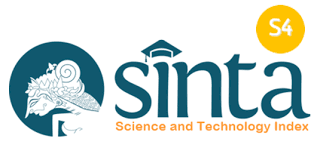ALAT PENGISIAN DAN PEMANTAUAN KETERSEDIAAN BAHAN BAKAR MINYAK DENGAN MENGGUNAKAN SENSOR PING DAN FLOW SENSOR
DOI:
https://doi.org/10.36080/skanika.v8i1.3288Keywords:
Sensor Ultrasonik/Ping, Flow Sensor, Blynk, Internet of Thing (IoT), CustomerAbstract
In Indonesia, fuel filling stations (SPBU) play an important role in the energy supply chain that supports community and economic mobility. Gas station management needs to focus on service quality and fuel availability for consumers. However, misuse by irresponsible parties often occurs, such as manipulation of the amount of fuel sold. This causes consumers to receive an amount of fuel that does not correspond to their payment, harming them and reducing the reputation of gas station managers. Technical errors, such as damage to dispensing machines, can also disrupt distribution. To overcome this problem, this research aims to develop a fuel monitoring and filling tool that uses a PING sensor and flow sensor. This sistem utilizes Internet of Things (IoT) technology to connect sensors in the tank and pump. Data from the sensors is sent to the Blynk platform for analysis. This real-time monitoring is expected to increase efficiency, accuracy and reliability of fuel distribution and reduce the potential for fraud. By implementing this sistem, consumers can feel more secure and confident that the fuel they receive is what they paid for.
Downloads
References
[2] M. R. Alfariski, M. Dhandi, and A. Kiswantono, “Automatic Transfer Switch (ATS) Using Arduino Uno, IoT-Based Relay and Monitoring,” JTECS: Jurnal Sistem Telekomunikasi Elektronika Sistem Kontrol Power Sistem dan Komputer, vol. 2, no. 1, pp. 1-8, 2022.
[3] F. A. Andika, et al, “Prototipe Sistem Kontrol POM Mini Berbasis Arduino,” Prosiding Seminar Nasional Inovasi Teknologi Terapan, 2022, pp. 94-99.
[4] M. I. Fadlila, M. Iqbal, M. Dahlan, “Rancang Bangun Pengisian Bahan Bakar Menggunakan Sensor Waterflow dan Monitoring Penjualan Berbasis Arduino dan Delphi,” Jurnal ELKON, vol. 3, no. 1, pp. 30–38, 2023.
[5] R. Halimatussa’diyah, et al, “Rancang Bangun Model Monitoring Underground Tank Spbu dengan Menggunakan Sensor Ultrasonik Berbasis Internet of Things (Iot),” Jurnal Informatika dan Teknik Elektro Terapan, vol. 12, no. 3S1, pp. 4463–4468, 2024.
[6] N. Sutarna, et al, “Implementasi Sensor Ultrasonik dan Flow Meter Pada Prototipe Pengisi Bahan Bakar Mini,” ELECTRICES: Jurnal Otomasi Kelistrikan dan Energi Terbarukan, vol. 5, no. 2, pp. 63–69, 2023.
[7] A. R. Azhar, et al, “Sistem Monitoring Kapasitas Air dan Pengisian Otomatis Berbasis IoT Menggunakan Modul ESP8266,” Jurnal Informatika dan Teknik Elektro Terapan, vol. 12, no. 1, pp. 218-228, 2024.
[8] N. Kristanti et al., “Penerapan Sensor Ultrasonik Pada Kotak Sampah Otomatis Menggunakan Telegram dan Alarm Suara,” Jurnal Teknik dan Sistem Komputer (JTIKOM), vol. 3, no. 2, pp. 67-78. 2022.
[9] R. A. Maulana, W. Windarto, “Rancang Bangun Pemilah Sampah Organik dan Non Organik Berbasis Mobile di Medang Lestari,” SKANIKA: Sistem Komputer dan Teknik Informatika, vol. 7, no. 1, pp. 12-21, 2024.
[10] P. E. A. Kaunang, S. R. U. A. Sompie, A. S. M. Lumenta, “Implementasi Google Internet of Things Core pada Monitoring Volume Ban Angin Mobil,” Jurnal Teknik Elektro dan Komputer, vol. 9, no. 3, pp. 163-170, 2020.
[11] C. Muttaqin, F. Nadziroh, and S. Nooriansyah, “Rancang Bangun Sistem Remote Menggunakan Module Infrared IR Wireless,” Jurnal Teknologi dan Terapan Bisnis (JTTB), vol. 5, no. 2, pp. 11–15, 2022.
[12] I. Irawan, J. C. Chandra, “Sistem Pemantauan dan Kendali Aquaponic Menggunakan Arduino Berbasis Web Web Based Aquaponic Control and Monitoring Sistem with Arduino,” KRESNA: Jurnal Riset dan Pengabdian Masyarakat, vol. 3, no. 1, pp. 77–85, 2023.
[13] M. I. Hakiki, U. Darusalam, and N. D. Nathasia, “Konfigurasi Arduino IDE untuk Monitoring Pendeteksi Suhu dan Kelembapan Pada Ruang Data Center Menggunakan Sensor DHT11,” Jurnal Media Informatika Budidarma, vol. 4, no. 1, pp. 150-156, 2020.
[14] M. Muliadi, A. Imran and M. Rasul, “Pengembangan Tempat Sampah Pintar Menggunakan ESP32,” Jurnal Media Elektrik, vol.17, no. 2, pp. 73-79, 2020.
[15] S. Subandi, M. A. Novianta, and D. F. Athallah, “Rancang Bangun Pembatasan Pemakaian Air Minum Berbasis Arduino Mega 2560 Pro Mini dengan Sensor Water Flow YF-S204,” Jurnal Elektrikal, vol. 8, no. 2, pp. 1-9, 2021.
[16] M. Natsir, D. B. Rendra, and A. D. Y. Anggara, “Implementasi IoT untuk Sistem Kendali AC Otomatis pada Ruang Kelas di Universitas Serang Rayam,” Jurnal PROSISKO, vol. 6, no. 1, pp. 69-72, 2019.
[17] A. Kamolan and L. Sampebatu, “Rancang Bangun Prototipe Pengaman Ruangan dengan Input Kode Pin dan Multi Sensor Berbasis Mikrokontroller,” Jurnal Ampere, vol. 6, no. 1, pp, 22-31, 2021.
Downloads
Published
How to Cite
Issue
Section
License
Copyright (c) 2025 Yamanotona Gulo, Irawan Irawan, Hendri Irawan

This work is licensed under a Creative Commons Attribution-ShareAlike 4.0 International License.
CC BY-SA 4.0
Creative Commons Attribution-ShareAlike 4.0 International
This license requires that reusers give credit to the creator. It allows reusers to distribute, remix, adapt, and build upon the material in any medium or format, even for commercial purposes. If others remix, adapt, or build upon the material, they must license the modified material under identical terms.
BY: Credit must be given to you, the creator.
SA: Adaptations must be shared under the same terms.ng












